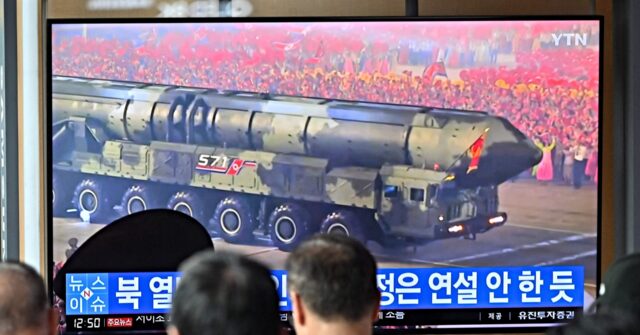The head of the International Atomic Energy Agency (IAEA), Rafael Grossi, urged the world to engage North Korea in remarks this week, emphasizing the threat of having a nation with a “completely off the charts” nuclear arsenal.
Grossi, who runs the United Nations agency on nuclear energy, called engagement with Pyongyang “indispensable,” particularly at the presidential level, and cited President Donald Trump’s letters to communist dictator Kim Jong-un as a positive example of “important” dialogue to keep the world safe.
North Korea is one of the world’s most repressive states, impoverishing its people by imposing decades of communism and funneling the nation’s economic resources into a growing, illegal nuclear weapons program. North Korea has not allowed the IAEA, whose mandate includes inspecting national nuclear weapons and nuclear energy programs, into the country since 2009. Kim has repeatedly and enthusiastically opposed calls for North Korea to halt its illegal nuclear weapons development, though the regime made a lucrative spectacle of allegedly dismantling its Punggye-ri Nuclear Test Site in 2018.
In 2022, during a period in which former President Joe Biden did little to address relations with the Korean Peninsula, evidence began surfacing that Pyongyang was working to rehabilitate the site.
Grossi addressed the situation with North Korea during an appearance at the Council on Foreign Relations (CFR) in Washington, DC, on Tuesday.
Noting that “a lot has happened” since the IAEA was “invited to leave” North Korea, Grossi lamented the significant growth of North Korea’s nuclear program in the past decade.
Total number of nuclear warhead stockpiles from 1945 to 2024, and the countries they are owned by. Data Source: FAS. (Graphic by Visual Capitalist via Getty Images)
“It has spawned exponentially. The program is no longer, you know, the complex at Yongbyon. It’s Kangson. It’s other places also in the country,” he explained. “It’s a light water reactor. It’s a second and perhaps a third enrichment facility being built at the moment. It’s a reprocessing campaign, which is ongoing as we speak. And there’s, you know, a nuclear arsenal that exists.”
The IAEA chief emphasized that the world needs “to engage” North Korea.
“I mean, you cannot have a country like this, which is completely off the charts with this nuclear arsenal,” he argued. “With such a big program, nuclear program, with all these facilities, without us having any clue of any safety or security measure which is being applied to it.”
“Engaging is indispensable,” he repeated. Addressing detractors of talks with the totalitarian regime, Grossi conceded, “you’re not going to get everything you want, especially when a country has acquired such a big nuclear arsenal.”
He added, however, that “presidential diplomacy is important,” citing the efforts President Trump made during his first term in office to reach out to Kim Jong-un.
“We need engagement from the top. And this is—you know, these exchanges of letters between President Trump and the leader … I think it is—it is important, for all the deficits this may have,” he suggested.
Grossi appeared to be intending to reference a series of letters, derisively referred to as “love letters” by anti-Trump media, published following the end of Preisdent Trump’s first term between Trump and Kim which were reportedly exchanged as part of greater diplomatic efforts during the first Trump presidency. The letters followed engagement between the two countries that received a jolt in the arm after President Trump published a message on Twitter in 2017 in which he asked, “Why would Kim Jong-un insult me by calling me ‘old,’ when I would NEVER call him “short and fat?”
Trump went on to meet Kim in person on several occasions and become the first American president to step foot on North Korean soil in 2018. Their last encounter occurred in Hanoi, Vietnam, in 2019, and ended with Trump walking out of their negotiations on policy.
“Basically, they wanted the sanctions lifted in their entirety and we couldn’t do that,” Trump told reporters. “He wants to de-nuke, but he wants to do some areas that aren’t what we want.”
The Biden administration did not engage North Korea in any meaningful way. During this time, in 2023, Kim announced a plan to “exponentially” increase the size of North Korea’s nuclear arsenal as a threat to South Korea and the United States.
“Now that the south [sic] Korean puppet forces who designated the DPRK [North Korea] as their ‘principal army’ and openly trumpet about ‘preparations for war’ have assumed our undoubted enemy,” Kim declared at the time, “it highlights the importance and necessity of a mass-producing of tactical nuclear weapons and calls for an exponential increase of the country’s nuclear arsenal.”
The Stockholm International Peace Research Institute (SIPRI) published a report in 2024 finding that North Korea likely possessed 50 nuclear weapons by the end of 2023, 20 more bombs than the study had found evidence for in 2022. The report also estimated that North Korea “possesses enough fissile material to reach a total of up to 90 warheads.”
“While North Korea conducted no nuclear test explosions in 2023, it appears to have carried out its first test of a short-range ballistic missile from a rudimentary silo,” the SIPRI report added. “It also completed the development of at least two types of land-attack cruise missile (LACM) designed to deliver nuclear weapons.”
Follow Frances Martel on Facebook and Twitter.
Read the full article here
